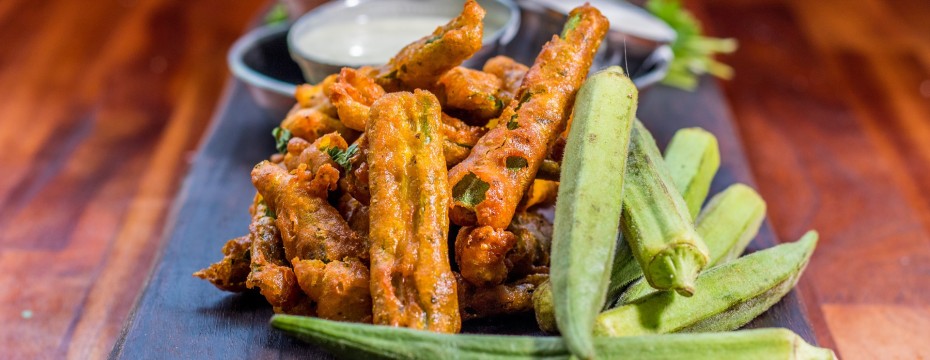Diversity can be attained even through the Palate!

A little over a year ago, I came to the US along with my teenage son to join my husband. Having spent a better part of the past decade in the US, my husband did not seem worried about finding food that would please his palate. He was pretty confident my son would do just fine. (It was obvious with his craze for pizzas, fries and burgers.) His only concern was – with my ‘restricted palate’ (read preference for home cooked Indian food), would I ever be able to manage.
Over the years, the online lessons I had been conducting to help my husband cook something edible gave me a fair idea of ingredients that could be sourced from the Indian / Asian stores, but seeing it for myself was an experience I am not sure words can describe.
On my very first visit to Patel Brothers – The Indian Grocery Store, among the other grocery items that conjured a map of the 29 states and 7 union territories of India, I found raw mango, raw jackfruit, lotus root, tinda, tapioca, ‘Saambaar Vegetable Mix’, all staring me in the eye; made me feel at home. If not in the fresh form, they were very much available in the frozen goods isle. I had never until then been a fan of frozen or even pre-cut vegetables, but now I do not seem to mind them. As life takes us to places far and wide, food continues to be a source of comfort.
Born to parents who moved out of their native land in search of employment, better opportunities and a better life on the whole, I was brought up on food which was a mix of the local staples and the traditional preparations that were the specialty of the native land that my parents had left behind. To make things clear and simpler to relate to, let me tell you that my parents were born and brought up in Kerala and moved to Pune, that is where I was born and brought up along with my siblings.
Availability of ingredients played a major role and customised versions of recipes evolved in the effort to keep the taste as close as possible to original while using locally available ingredients. The vegetable vendor round the corner sold a set of fresh vegetables calling them ’Sambaar Vegetables’ (One would think it is a modern concept, the only difference is in the US you get it in frozen form), it was a big hit then. One could choose to buy a set ranging from 250 gm to 1 kg depending on the size of one’s family. Adding a variety of vegetables to sambaar is common, buying each vegetable separately would cost a fortune, and then no one would sell vegetables in such small quantities.
Good food never goes unnoticed. While my friends at school and my neighbours salivated to the aromas of ‘Sambaar’ – lentils cooked with vegetables and spices, and ‘Avial’ – mixed vegetables cooked in coconut and curd / tamarind, that Amma made, I found myself craving for the ‘Bharleli Vaangi’ (stuffed aubergine masala) that my neighbour and Landlady, whom we lovingly called Maavshi, prepared. Another attraction on the Maharashtrain platter was the Oh so simple ‘Bhakri’ – flat bread made out of coarse millet flour. While ‘Chapatis’ – flatbread made of fine wheat flour, had over the years become a staple at home, the skill required to make a good Bhakri eluded Amma.
Then there was the ‘Harbaryachi Bhaaji’- tender leaves of chickpea plant cooked to perfection. I watched Maavshi clean the leaves to prepare the vegetable. The cleaning took hours, as it involved separating tender leaves from the stems and looking out for tiny worms which in local lingo were called ‘Aali’, the camouflage made the task almost impossible. It was a seasonal delicacy and was restricted to limited portions owing to the fact that large quantities of tender leaves meticulously cleaned when cooked were reduced to a very small quantity. Everyone got a fixed share, no refills.
Our annual trip to Kerala during the summer vacations ensured we got to gorge on vegetables like raw papaya, raw banana, raw mangoes, raw jackfruit and jackfruit seeds. Raw mangoes enhanced the flavour of “Meen Curry’ – fish curry and ‘Chhammandi’ the spicy coconut chutney; while ripe mangoes were cooked to perfection along with spiced coconut and curd gravy called ‘Maampazha Pulisheri’. Raw jackfruit required an entire team of skilled individuals to be involved in cutting and ensuring the edible part was skillfully separated with hands that had a liberal coating of coconut oil to prevent the sticky sap from getting plastered on to them.
The non-availability of these ingredients and the difficulty to source them along with their flared up prices back in Pune, made Amma rely on the easy to procure and reasonably priced vaangi (aubergine), bhindi (okra), gavaar (cluster beans), and kaarli (bitter guard). The availability of greens like paalak (spinach), methi (fenugreek leaves), kothimbir / dhaniya (corriander leaves), pudina (mint leaves) was a blessing. I had often heard my Aunts in Kerala express amusement when Amma told them about these greens and the delicious dishes that could be made from them. Don’t be surprised, they had never even heard of them, leave alone seen or eaten them. Thanks to stores like Big Bazar, the past few years have marked a change in this trend.
Life went on, my eldest sister (Chechi) started college, it was during that time that her newfound interest in cooking diversified our food options. As she attempted preparing a wider variety, I started looking forward to the occasional ‘Pav Bhaaji’, ‘Veg Pulav’ ‘Aamti’ and ‘Varan’. When Chechi got married, things got back to the routine till my love for food forced me to take up cooking. I tried to follow both Amma’s and Chechi’s cooking styles along with being influenced by Maavshi’s while trying to find my way in the world of cooking.
Life does have its way of surprising you, and expecting the unexpected seems to be the norm. I went on to get married to the love of my life who happens to be a Punjabi. (If you are thinking of ‘Two States’ don’t even try, there is no similarity whatsoever.) Yes, you guessed it right, it was my introduction to ‘Chhole Bhature’ – spiced chickpea curry with fried fluffed bread, ‘Stuffed Paranthaas’ – flat bread stuffed with a whole range of stuffings, ‘Dahi Bhalla’ fried lentil balls dipped in curd flavoured with cumin and other spices, ‘Daal Makhani’ – creamy black lentil curry, ‘Makki Ki Roti Sarson Ka Saag’ seasonal greens cooked in onion and tomatoes along with flat bread made of corn flour.
During my visits to the vegetable market along with my parents in law, I made friends with tinda, navalkaul, and the most fascinating kamal kakdi (lotus root). Now here was another vegetable much relished but very tedious to clean and prepare. Sourced from slushy or marshy areas, the root of the lotus plant is hollow and the vendors prefer keeping the wet mud on to ensure its freshness, making the cleaning process very tedious. My Grandparents in law had moved to Jamshedpur to start a family and thus my father in law grew up enjoying Bengali food as well. Thus was discovered the common craving for various preparations of raw banana and raw jackfruit.
In the course of our journey called life, we spent a couple of years in Thane, close to Mumbai. Proximity to the coast meant availability of ingredients like raw mango, raw banana and raw jackfruit. They were supplied from the Ratnagiri belt. Our love for seafood found a new leash of life during those years.
Following life as it led us on to another escapade, we moved to Hyderabad. It was a journey of discoveries, a completely different ball game. The first few visits to the grocery stores left me baffled, I felt badgered by the choices, or lack of it, that seemed to start and end at some or the other variety of ‘Venkai’ – aubergine. There was purple, green, yellow, white with purple and green shades, not to forget the size and shape variations. Slowly as we ventured into the local markets (read Raithu Bazaar) we acquainted ourselves with totakkura, gongura, and other greens and as the markets evolved the influx of vegetables from neighbouring states did not leave much to be desired. Over the years our love for Biryani, Haleem, Venkaya Kura, Gongura Curry, Raagi Sankati and Punugulu made us love Hyderabad for its food more than anything else.
We feel truly settled and happy when we have access to comfort food and ingredients required to prepare a customised version of it. The knowledge of where to procure these ingredients, makes us feel at home. I have thanked and will continue to thank a million times people who ventured out of their native lands and made their presence felt not only in different states all over India, but in countries all over the world. Their escapades and determination to source comfort food has made life easy for people who follow in their footsteps.
While enjoying cuisines from all over the world be it Mexican, Italian, French, Middle Eastern, Chinese, Thai or American, I am glad that I have comfort food available whenever I want. And guess what, a little over a year here, and my palate is not as ‘restricted’.
Local cuisines and new tastes are welcome, but it is such a blessing to have a choice.
Luckily now I don’t have to clean raw jackfruit or lotus root for all comes in ready to cook frozen packs. In this short time, I have come up with a whole range of customized recipes, the ingredients for which can be procured locally. And at least I would like to believe that the taste is a close as it can get to food back home. In all of this, I do miss those visits to the local markets in India.





